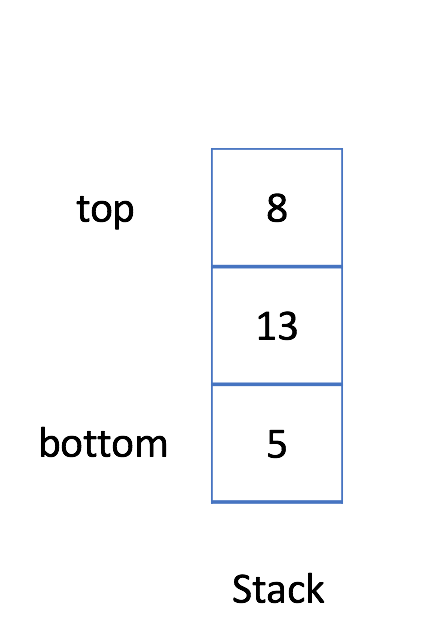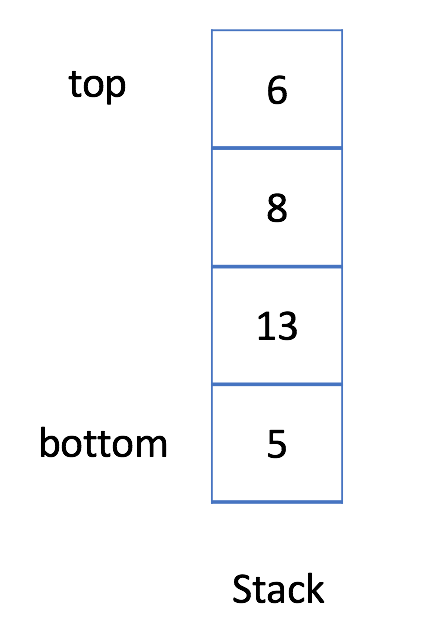資料結構與演算法之 棧(Stack)的Java實現
阿新 • • 發佈:2018-12-12
後入先出的資料結構
在 LIFO 資料結構中,將首先處理新增到佇列中的最新元素。
與佇列不同,棧是一個 LIFO 資料結構。通常,插入操作在棧中被稱作入棧 push 。與佇列類似,總是在堆疊的末尾新增一個新元素。但是,刪除操作,退棧 pop ,將始終刪除佇列中相對於它的最後一個元素。
示例 - 棧
1. 入棧:你可以單擊下面的 Push 按鈕檢視如何將新元素 6 新增到棧中。
2. 退棧:你可以單擊下面的 Pop 按鈕檢視當你從棧中彈出一個元素時將移除哪個元素。
 Push
Push  Pop
Pop
實現 - 棧
棧的實現比佇列容易。動態陣列
// "static void main" must be defined in a public class. class MyStack { private List<Integer> data; // store elements public MyStack() { data = new ArrayList<>(); } /** Insert an element into the stack. */ public void push(int x) { data.add(x); } /** Checks whether the queue is empty or not. */ public boolean isEmpty() { return data.isEmpty(); } /** Get the top item from the queue. */ public int top() { return data.get(data.size() - 1); } /** Delete an element from the queue. Return true if the operation is successful. */ public boolean pop() { if (isEmpty()) { return false; } data.remove(data.size() - 1); return true; } }; public class Main { public static void main(String[] args) { MyStack s = new MyStack(); s.push(1); s.push(2); s.push(3); for (int i = 0; i < 4; ++i) { if (!s.isEmpty()) { System.out.println(s.top()); } System.out.println(s.pop()); } } }
棧 - 用法
大多數流行的語言都提供了內建的棧庫,因此你不必重新發明輪子。除了初始化,我們還需要知道如何使用兩個最重要的操作:入棧和退棧。除此之外,你應該能夠從棧中獲得頂部元素。下面是一些供你參考的程式碼示例:
// "static void main" must be defined in a public class. public class Main { public static void main(String[] args) { // 1. Initialize a stack. Stack<Integer> s = new Stack<>(); // 2. Push new element. s.push(5); s.push(13); s.push(8); s.push(6); // 3. Check if stack is empty. if (s.empty() == true) { System.out.println("Stack is empty!"); return; } // 4. Pop an element. s.pop(); // 5. Get the top element. System.out.println("The top element is: " + s.peek()); // 6. Get the size of the stack. System.out.println("The size is: " + s.size()); } }
從現在開始,我們可以使用內建的棧庫來更方便地解決問題。 讓我們從一個有趣的問題(最小棧)開始,幫助你複習有用的操作。 然後我們將看一些經典的棧問題。 當你想首先處理最後一個元素時,棧將是最合適的資料結構。
最小棧
設計一個支援 push,pop,top 操作,並能在常數時間內檢索到最小元素的棧。
- push(x) -- 將元素 x 推入棧中。
- pop() -- 刪除棧頂的元素。
- top() -- 獲取棧頂元素。
- getMin() -- 檢索棧中的最小元素。
示例:
MinStack minStack = new MinStack(); minStack.push(-2); minStack.push(0); minStack.push(-3); minStack.getMin(); --> 返回 -3. minStack.pop(); minStack.top(); --> 返回 0. minStack.getMin(); --> 返回 -2.
程式碼如下:
public class MinStack {
ArrayList<Integer> minstack ;
int Top=-1;
public MinStack() {
minstack= new ArrayList<>();
}
public void push(int x) {
minstack.add(x);
Top++;
}
public void pop() {
minstack.remove(Top);
Top--;
}
public int top() {
return minstack.get(Top);
}
public int getMin() {
int min=minstack.get(0);
for(int i:minstack){
if(i<min){
min=i;
}
}
return min;
}
public static void main(String[] args) {
MinStack minStack = new MinStack();
minStack.push(-2);
minStack.push(0);
minStack.push(-3);
System.out.println(minStack.getMin());
minStack.pop();
System.out.println(minStack.top());
System.out.println( minStack.getMin());
}
}

